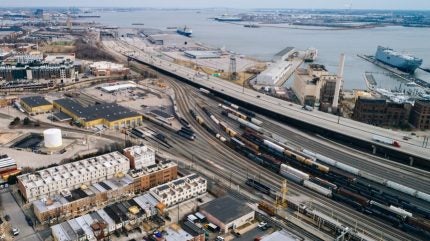
In an interconnected world, it’s no surprise that the collapse of the Baltimore Francis Scott Key bridge has created knock-on impacts for US and global trade.
Several ports and yards are currently unreachable by sea, with little idea of when the wreckage will be cleared and access restored. At least two CSX facilities, including a large automotive export facility at its Curtis Bay yard are beyond the fallen bridge, along with Norfolk Southern’s Dundalk Marine Terminal, which is linked by rail to its Intermodal Terminal in Baltimore.
Crucially, the Sparrow’s Point industrial facility to the East of the bridge does not have the port facilities needed to offload containers or bulk, and move it to the rail connections at the hub for distribution centres.
Maersk, which had chartered the Dali at the time of the crash, said it was “omitting” Baltimore for the foreseeable future, but told its customers it would offload at other East Coast ports.
“For cargo already on water, we will omit the port, and will discharge cargo set for Baltimore, in nearby ports. From these ports, it will be possible to utilise landside transportation to reach final destination instead,” it said in an advisory.
Likewise, COSCO Shipping said it would invoke the “force majeure” clause in its terms and conditions, and instructed customers to contact its representatives to organise “alternative port of loading options”.

US Tariffs are shifting - will you react or anticipate?
Don’t let policy changes catch you off guard. Stay proactive with real-time data and expert analysis.
By GlobalDataThe two major rail freight operators at Baltimore’s ports are Norfolk Southern (NS) and CSX, both of which made statements regarding the immediate future of intermodal freight on the US East Coast.
“Ports on the East Coast are resilient and have the capacity to serve the flow of freight,” the NS railroad said.
According to Freightos’ head of research, Judah Levine, said New York/New Jersey, Norfolk, VA, Charleston, SC, and Savannah, GA, would be the ports most likely to take traffic that can no longer reach Baltimore.
“Significant supply chain events demand a rapid response approach, frequent communication, and innovative solutions, and Norfolk Southern is doing all three of these things to help our customers and partners navigate through this challenge.”
Meanwhile, CSX said while some customers would be affected, it would keep its rail yards operational for as long as possible.
“In-gated traffic originating from other locations and destined for Baltimore is on hold until further notice. The CSX team is working with International customers to identify alternative solutions to support cargo movement to and from Baltimore. It’s important to note that domestic intermodal traffic on CSX destined for local Baltimore remains unaffected. CSX is committed to keeping customers informed and will continue to provide updates as information becomes available.”
CSX said its key coal facility at Curtis Bay, to the south of the Baltimore Port area, would remain operational as long as it does not reach pile limits.
“CSX currently has capacity to dispatch additional trains to CSX-served coal terminals in Baltimore before reaching pile space limits. Contingency plans are being implemented and CSX is in contact with existing coal customers through these terminals. The company currently intends to keep its Curtis Bay Coal Pier facility operational but will continue to assess the circumstances to determine appropriate actions moving forward,” it explained.



